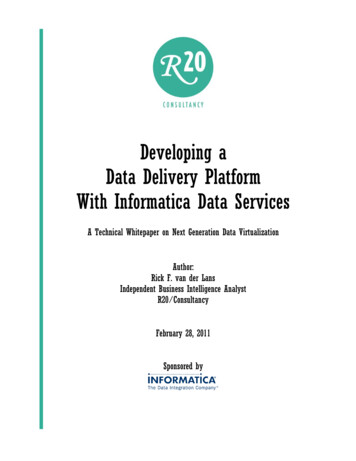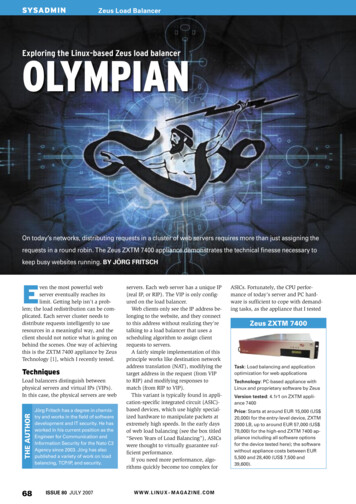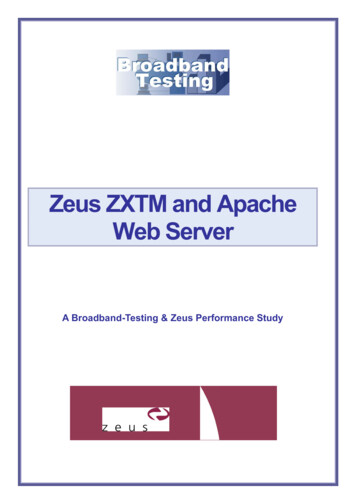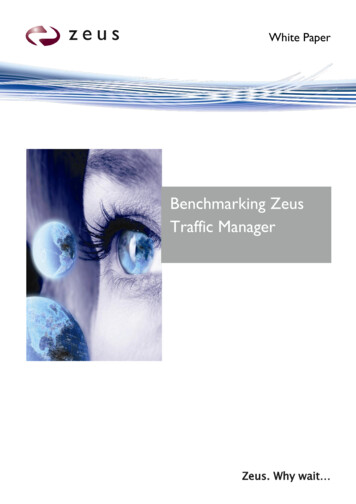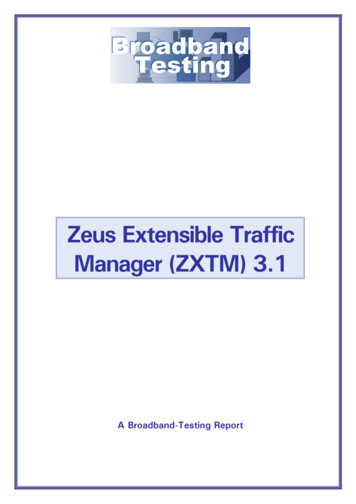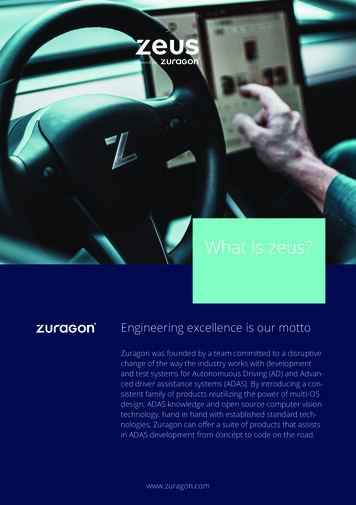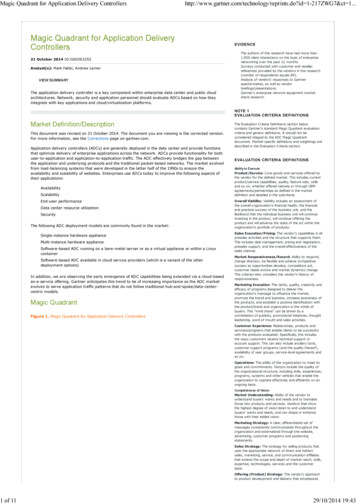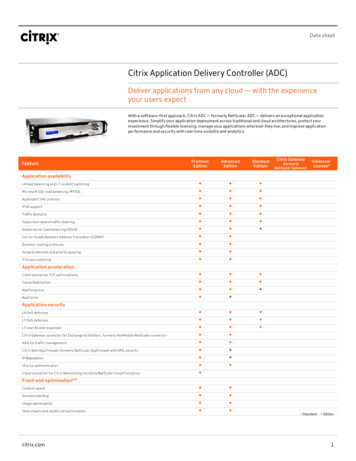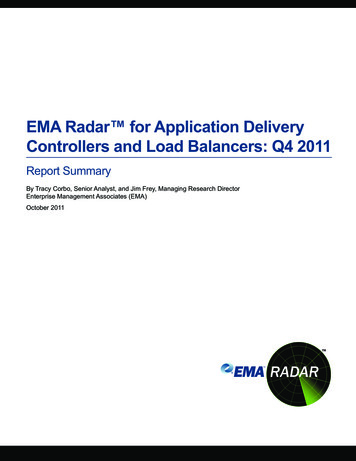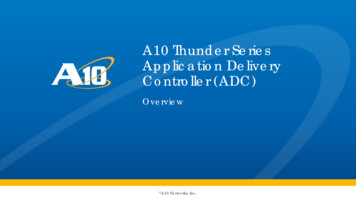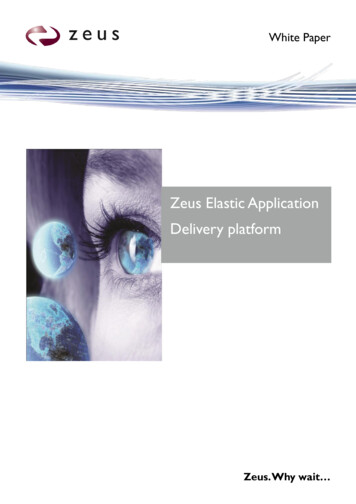
Transcription
White PaperZeus Elastic ApplicationDelivery platformZeus. Why wait
ContentsZeus Elastic Application Delivery platform . 3Introduction. 3Components in Zeus Elastic Application Delivery platform. 4Components . 5Zeus Multi-Site Manager . 5Global Load Balancer . 5Zeus Traffic Manager . 5Supported application deployment platforms. 6Using Zeus Elastic Application Delivery platform . 7Multi-site application deployment . 7Resource bursting and scaling . 8Development, Test and Production locations . 8Infrastructure management . 9Benefit: Create exceptional online services . 10Benefit: Manage exceptional online services . 11Benefit: Deliver exceptional online services . 12Conclusion . 13For more information .13Z E U S E L A S T I C A P P L I C A T I O N D E L I V E RY P L AT F O R MPAGE 2 OF 14Zeus. Why wait.
Zeus Elastic Application Delivery platformIntroductionThe next 5 years promise a revolution the provision of internet applications. Organizationswill progress by way of internal, private cloud technology, towards wide-scale distributedapplications that take advantage of the cheap, mobile and ubiquitous nature of publiccloud computing. The challenges of managing traffic and providing consistent levels ofservice will become significant, and organizations should look towards technology such asZeus’ Elastic Application Delivery platform to meet these needs.The last 5 years have been the half-decade of the client device. The phenomenal uptakeof smart phones and other mobile devices has been driven by a confluence of commercialand technological factors. No longer can an organization just consider fixed, static clientdevices with a known set of capabilities, but must tailor services for a wide variety of clienttypes with varying capabilities and resources.The next 5 years promise a similar revolution for the server-side of web basedapplications.The economies of scale, advances in hardware performance and technicaladvances in virtualization have created a new environment where server resources arecheap, mobile and ubiquitous.In the space of 5 months, the number of web servicesrunning on the Amazon EC2 public cloud grew 33%, to over 365,0001.Analysts predict that the growth of the public cloud will be dwarfed by organizationsdeploying private cloud infrastructure internally. Whereas IDC estimates 0.7bn spend onservers for public cloud infrastructure by 2014, in the same period they predict 11.8bnserver spend for pure private clouds2 - automated, converged and virtualized server,storage and network fficient,scalableandautomatedinfrastructure for applications, but bring concerns of reliability, availability, performanceand security. Early adopters have found that although the benefits are well within reach,management and monitoring tools are lacking in the face of fluid and scalableinfrastructures. Users of multi-tenant cloud services must be mindful of the challenges ofmaintaining the level of service their users are accustomed to receiving from priordedicated /2010/05/14/may 2010 web server rId 223118Z E U S E L A S T I C A P P L I C A T I O N D E L I V E RY P L AT F O R MPAGE 3 OF 14Zeus. Why wait.
Components in Zeus Elastic Application Delivery platformThe Zeus Elastic Application Delivery platform provides a mature, scalable trafficmanagement fabric that underpins applications delivered from any combination of physical,virtual or cloud-based datacenters.This platform allows you to: Reduce risk and contain costs by enabling the use of multiple datacenters,including cloud resources, and by routing and shaping traffic and dynamically scalingapplications to provide the capacity required by the current load; Gain a global perspective of application performance and reliability acrossmultiple locations, with detailed visualization and reporting to understand traffic trendsand manage user interactions in real time; Improve your service performance and availability using both global and localload balancing techniques and application acceleration capabilities, and TrafficScriptpolicies to route, prioritize and secure traffic.Organizations depend on Zeus to deliver complex applications in large-scale environments,spanning multiple locations, using multiple protocols and services, in a reliable, highperformance, secure manner.Zeus Elastic Application Delivery platform components,spanning physical, virtual and cloud environmentsZ E U S E L A S T I C A P P L I C A T I O N D E L I V E RY P L AT F O R MPAGE 4 OF 14Zeus. Why wait.
ComponentsThe Zeus Elastic Application Delivery platform contains three key components: Multi-Site Manager for management of the entire traffic management fabric; Global Load Balancer for global traffic management; Zeus Traffic Manager for local traffic management.Zeus Multi-Site ManagerThe Zeus Multi-Site Manager component coordinates the activities of the Zeus TrafficManager and Global Load Balancer components across multiple locations. It provides aglobal view of application configuration, activity and health.Global Load BalancerThe Global Load Balancer component controls how users access services on a global basis.When a service is provided from multiple locations, Global Load Balancer controls whichlocation each user is directed to.The routing decision can consider service availability,service performance, geographic proximity and custom business policies that may serve tominimize cost or enforce security policies.Zeus Traffic ManagerThe Zeus Traffic Manager component performs local load balancing and traffic managementwithin each datacenter location. It inspects, manages and routes all user interactions withthe local services to ensure that services run at maximum efficiency, that users receive thebest possible level of service, and that local security and business policies are applied.Z E U S E L A S T I C A P P L I C A T I O N D E L I V E RY P L AT F O R MPAGE 5 OF 14Zeus. Why wait.
Supported application deployment platformsThe Zeus Elastic Application Delivery platform is based purely on software technology.Zeus’ unique application acceleration and offload functionality utilizes general-purposecompute resources and does not depend on assistance from hardware accelerators.Zeus Elastic Application Delivery platform supportsthe widest range of deployment environmentsConsequently, Zeus platform components may be installed in any physical serverenvironment, in any virtualization environment and on a very large majority of cloudInfrastructure-as-a-Service platforms.This affords great flexibility in deployment choice. Software components may be scaled upand down rapidly, and the Zeus platform presents a consistent application delivery fabricfor applications, no matter what environment they are installed in.Z E U S E L A S T I C A P P L I C A T I O N D E L I V E RY P L AT F O R MPAGE 6 OF 14Zeus. Why wait.
Using Zeus Elastic Application Delivery platformMulti-site application deploymentWhen an application or service is deployed from multiple locations simultaneously, theZeus platform manages traffic to and within each location based on business priorities anddeployment strategies.Wide-area (global) load balancing(traffic directed across multiple locations)Disaster recovery(US fails over to ntDevelopmentenvironmentTraffic Management units are deployed in each location, with integrated management fromZeus Multi-Site Manager and global traffic direction using Global Load Balancer.Zeus Elastic Application Delivery platform manages traffic across all locationsdepending on business policy, availability and service performance Disaster recovery: One location can be nominated ‘master’, with the remaininglocations configured as failover slaves.All traffic is directed to the master unless itfails completely, in which case traffic is directed to the nominated failover. In the eventof compound failures, a failover chain defines which location is used.Failback when the master recovers may be automatic, but most commonly anorganization uses the Zeus platform either to orchestrate the failback once the masterhas synced with the active slave, or simply nominates the active slave as the newmaster and reconfigured the failover chain.Zeus’ Autoscaling capability may be used to ensure that the minimum resources arerunning in each warm slave location. This way, correct operation of the slave locationcan be verified by Zeus’ monitors, and additional capacity can be brought online ondemand if live traffic is transferred to the slave.Z E U S E L A S T I C A P P L I C A T I O N D E L I V E RY P L AT F O R MPAGE 7 OF 14Zeus. Why wait.
Multiple Active Sites: The Zeus platform can load-balance traffic between multipleactive sites simultaneously, typically in order to optimize user service levels by routingeach user to the location that is geographically closest. Health monitors ensure thatthis technique is resilient to location failure.Advanced routing rules may be deployed to implement custom global load balancingpolicies. For example, as a first line of defence, you may wish to route all traffic froman embargoed country to an alternative location, or in the case of a development andproduction environment, route internal traffic to the test site, and external traffic tothe production one.Where an application or service consists of multiple components, the Zeus platform canroute each component individually.For example, a retail application may be distributedglobally for performance reasons, but the payment gateway located in a central locationfor compliance and security reasons.Routing may be based on global redirection usingmultiple service names (DNS names), or may use internal forwarding with full SSLencryption if based on request parameters.Resource bursting and scalingThe Zeus platform supports cloud bursting by dynamically routing traffic betweenlocations; traffic can be migrated on a global and local basis from one point of presence(such as a fixed-size internal resource) to a second (such as an external cloud).Zeus’ application auto-scaling capability scales applications on cloud or virtual platforms‘on demand’; for example, in response to service degradation due to traffic spikes.Cloud bursting can be used to good effect with auto scaling.An idle instance of anapplication may run continually on a cloud platform with minimal resource, continuallytested to verify correct operation and ready to scale on demand if traffic is migrated.Development, Test and Production locationsMulti-Site Manager controls and reconciles traffic management policies across multiplelocations, and is an ideal platform for integrated dev, test and production environments.Test/ staging environmentProduction environmentMultiple small, independentdevelopment environmentsConfiguration for the development location may be imported and exported from a sourcecontrol system, so traffic management policies and load balancing rules can be developedin parallel with application code.Z E U S E L A S T I C A P P L I C A T I O N D E L I V E RY P L AT F O R MPAGE 8 OF 14Zeus. Why wait.
Multi-Site Manager makes it straightforward to import updated configuration from the devto test environments for final acceptance testing. Zeus’ rich suite of APIs can automatethis process to eliminate the chance of manual error if required.Similarly, accepted configuration can be deployed on the ‘production’ location, and fullauditing gives a change log so that updates can be tracked.Infrastructure managementMulti-site Manager’s rich UI presents diagnostic information, activity graphs and logs andfull application delivery configuration in a single, global view.Traffic distribution changes can be orchestrated or conducted manually, and typicalinfrastructure changes can be made in a controlled, reproducible manner with no loss ofend user traffic and no loss of sessions.For example, if one location should be taken offline because it is no longer required, GlobalLoad Balancer can drain that location and route new users to alternative service endpoints.Traffic received at that location can be routed internally to the new endpoint. Multi-SiteManager’s UI will report on usage across the application estate so that the administratorcan track when all user sessions have expired and it is safe to decommission the location.Within a location, Zeus Traffic Manager’s ‘connection draining’ capability can be used todrain traffic away from an individual server, yet ensure that essential user sessions remainuntil the session expires.This way, a server can be safely taken out of service, forexample, for a routine upgrade, without interrupting any user transactions.Finally, Zeus Traffic Manager’s powerful connection tracking capabilities can be used toupgrade applications on-the-fly, running old and new generations of an applicationconcurrently and migrating users from the old to the new as their sessions complete.Z E U S E L A S T I C A P P L I C A T I O N D E L I V E RY P L AT F O R MPAGE 9 OF 14Zeus. Why wait.
Benefit: Create exceptional online servicesZeus Elastic Application Delivery platform controls how your customers use your onlineservices. It is the ideal location to orchestrate interactions with complex applications, toimplement access, prioritization and routing logic, and to quickly and securely resolveapplication problems.Zeus’ free Development License and IDE integration makes Zeus Traffic Manageravailable to any developer, for any non-production purpose, at no cost.Whenever youcreate a new application, you can easily take advantage of Zeus’ traffic managementfunctionality within that app.Zeus Elastic Application Delivery platform is the ideal platform to control howcustomers use your applications.For example, you can create business rules thatdefine how user interactions should be prioritized and deploy these on the traffic manager.Zeus Traffic Manager can also host application logic to route users to the correct version ofan application, to perform security checking and to transform and optimize requests andresponses.Because it manages and controls user interactions before they reach your applications,Zeus Elastic Application Delivery platform enables a much more agile, dynamic andresponsive architecture, resulting in significant operational efficiencies.Business Traffic Management policies may be written using RuleBuilder, TrafficScript orJava: RuleBuilder is a simple, easy-to-use graphical interface to create simple businessrules to manage traffic; TrafficScript gives complete control, allowing you to create sophisticated policies thatmanipulate traffic and fully control how each request is managed and prioritized; Java: For the ultimate flexibility, traffic management rules may be written in Java, apowerful and familiar programming environment. Traffic Management rules may alsobe written in Ruby, Python or any other language that can target the Java VirtualMachine.Z E U S E L A S T I C A P P L I C A T I O N D E L I V E RY P L AT F O R MPAGE 10 OF 14Zeus. Why wait.
Benefit: Manage exceptional online servicesZeus Elastic Application Delivery platform provides key metrics to monitor the servicelevels, availability and use of your services, even across multiple, distributed locations.Detailed diagnostics and visualization tools allow you to rapidly diagnose and resolveapplication problems. It facilitates routine management tasks and eliminates downtime byintelligently routing and draining traffic between locations, servers and applications.Zeus improves your operational efficiencies.It provides a single dashboard tovisualize and report on service levels, availability and traffic levels. Full traffic visualizationand logging, along with a detailed on-demand diagnostics report gives you themanagement information you require to rapidly resolve application problems and forecastfuture infrastructure needs.Real-Time Analytics allows you to drill down, in real time, to inspect your traffic andisolate problem cases.For example, in the case of a denial of service attack, you canquickly identify the properties of the attack traffic and deploy a TrafficScript policy tocontrol that traffic.Service Level Monitoring checks that your services comply with your desired servicelevels. If the performance falls outside your desired Service Level, Zeus Traffic Managercan automatically invoke new traffic management policies to deal with the ructurerequirementsforyou,automatically adding or removing servers of the appropriate type on supported virtual andcloud infrastructures.Zeus provides a range of management interfaces for complete integration with externalsystems.The Zeus platform observes service health and all user interactions, and caninform datacenter monitoring services when key events occur. Open APIs (a standardsbased SOAP API and a CLI interface) can be used to push infrastructure changes to theplatform in order to participate in enterprise-scale management services.Z E U S E L A S T I C A P P L I C A T I O N D E L I V E RY P L AT F O R MPAGE 11 OF 14Zeus. Why wait.
Benefit: Deliver exceptional online servicesZeus Elastic Application Delivery platform ensures the successful delivery of your services.It intelligently load-balances traffic across your infrastructure, accelerating and optimizingeach request to deliver the best possible performance and maximize efficiency. Advancedhealth monitoring and failover protects services from a wide range of failures, andapplication firewalling and traffic shaping secures your services from malicious requestsand floods of traffic.To ensure maximum availability, Load Balancing, Health Monitoring and SessionPersistence track the activity of each user accessing your service. Load Balancing selectsthe optimal location for each user, and the optimal server node for each request, informedby user session information and server health.TrafficCluster failover provides multiplelevels of resilience for the traffic manager itself.To deliver maximum performance and efficiency, Zeus employs a combination ofoptimization techniques.Content Caching responds rapidly to common requests andreduces the volume of transactions; HTTP and T
The Zeus Traffic Manager component performs local load balancing and traffic management within each datacenter location. It inspects, manages and routes all user interactions with the local services to ensure that s
